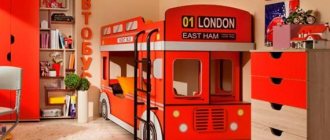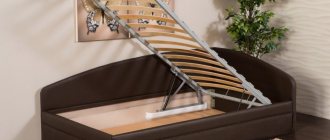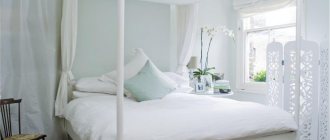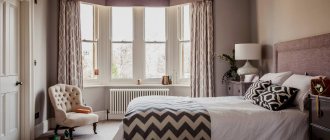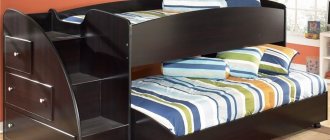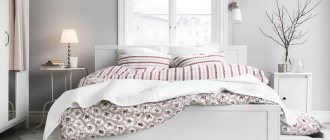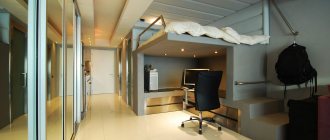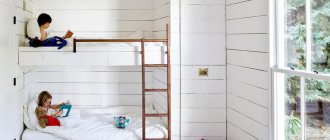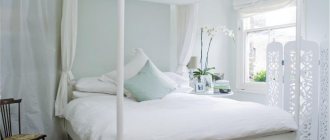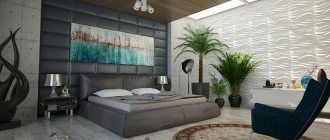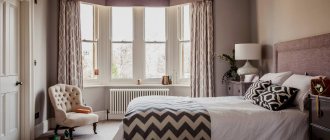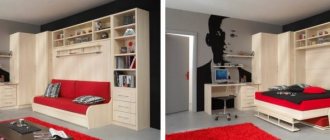Contrary to popular belief, bunk beds are not only suitable for children's rooms; they are an excellent solution in any situation when it comes to saving useful space. This option is optimal for large families, installation in dachas, dormitories, hostels, rest areas for seasonal workers or soldiers. And although wooden furniture will always be out of competition, a metal bunk bed is also quite popular and boasts a considerable number of advantages. The metal structure is very strong and stable, it can withstand heavy loads without deforming, and is characterized by a long service life. The features of such furniture, the rules for choosing and caring for it will be discussed in the article.
Advantages and disadvantages
A metal bunk bed is a functional option that is perfect for residential premises, hotels, country and country houses. The main feature of the product is the location of the sleeping places: they are located on top of each other. This is what makes the design more compact and allows it to be conveniently placed in small rooms.
A two-level metal bed is characterized by a number of positive properties:
- Compactness - the second sleeping place is located at the top, and not on the side, so the furniture takes up a minimum of space, which allows it to be installed in small rooms.
- Functionality - the design is equipped with additional elements: drawers for linen, a table, a chest of drawers.
- Originality - to order, from one frame you can make a bunk bed of the desired design and with any dimensions, even non-standard ones.
- Comfort – the product is manufactured in strict compliance with all standards for bedroom furniture; resting on such a bed is no less comfortable than on the usual “single-story” beds.
- Reasonable cost - purchasing this model will cost less than two single-seat options; there are even budget offers that can fit quite organically into modern design and last a considerable time.
However, do not forget that metal products have certain disadvantages:
- Processing this raw material is a technically complex procedure, so beds are produced in limited quantities, their range is much more modest, especially compared to their wooden counterparts.
- The material has good thermal conductivity, so in summer the furniture will get very hot.
- The metal is susceptible to corrosion; for protection, a special polymer coating must be applied to the surface, which should not be subjected to mechanical stress, otherwise its functionality will be impaired.
- There is a fairly high level of injury risk; impacts on a metal surface (which is not uncommon for little fidgets) will result in bruises, at a minimum.
Important positive properties of a metal structure are a high level of fire safety and hygiene; microbes do not multiply on such a surface.
Iron bunk bed manufacturing technology
To make a bunk bed out of metal with your own hands, you will need a 50x25 metal profile to create bed frames, a 20x25 section profile to make a slatted base for the mattress, and 40x40 mm metal elements for the side posts. You will also need to purchase metal screws, screws, primer and paint for metal surfaces.
Using a grinder you need to cut all the components from the profile pipe, which are then welded together
Based on the drawing of a children's bunk bed, you cut all the blanks to a given length with your own hands. Assembly of the structure begins with the creation of backrests in the amount of 4 pieces. The structural elements must be laid out on a horizontal surface and connected with a welding seam. After each step, it is recommended to check the angle, which should be 90 degrees.
Using a grinder, slats for the mattress are cut from a 20x25 mm profile pipe. Next, the base is assembled. On long frame parts, 12 metal strips are welded at equal distances from each other. Then it is necessary to connect the vertical posts in pairs, to which the backs of the lower and upper tiers are attached by welding. The result is two designs.
The frame for the mattress of the lower tier is welded to the first at a distance of 35 cm from the floor, and for the upper floor - at a distance of 95 cm from the lower level. All actions are carried out according to the drawing of a children's bed with your own hands.
In the places where the frames of the second rack are attached, it is necessary to weld two sections of a profile measuring 20x20 mm. They should be installed with some clearance, since the elements must fit tightly into the inner part of the profile measuring 50x25 mm. This technique will allow the structure to be transported in the future without losing the strength and rigidity of the connections.
A metal bunk bed is the most durable and durable
The final stage is the manufacture of a staircase 36 cm wide. Using a grinder, all the component elements are cut from a profile pipe and welded together. The structure is attached to the bed using self-tapping screws.
After the bunk bed is assembled, all seams are sanded, the surface is cleaned of dust and the base is primed with a special compound. After it has completely dried, metal paint is applied to the structure in two layers.
Varieties
Manufacturers offer a wide range of bunk beds with metal frames. They differ in design, shape, and design. There are models with additional furniture elements, functional products with a sofa underneath, options for adults and children.
Children's
A metal bunk bed for children is usually chosen for a room with a small area. Among the most popular options for children:
- classic designs with two berths and a high level of safety;
- attic - a two-story model for one child, the bed itself for sleeping is usually located at the top, and below there is a wardrobe and an area for toys;
- bunk bed with drawers and cabinets - looks original, is functional, and provides additional convenience.
Such children's bedroom furniture is a standard compact and practical bed, characterized by durability, mobility, and aesthetic design. Each model is necessarily equipped with protective sides to prevent the child from falling during sleep, and a ladder for comfortable movement to the upper “floor”.
The design should be comfortable and safe. It is worth remembering that children love to play outdoor games, run, jump, so they may accidentally hit themselves. To protect them from injury, it is better to purchase products without sharp corners and with soft upholstery. Don’t forget about the aesthetic component - a bed painted in bright colors with interesting decorative elements is perfect for a child’s room.
Adults
Iron beds for adults with two tiers will also be an excellent solution for small apartments, especially when the children have grown up and the living space remains the same. They are also often installed in guest rooms, country and country houses, hotels, and student dormitories.
Main features of adult beds:
- provide large dimensions, the length can reach 2 m, for some models this parameter is adjusted independently by moving and extending the structure;
- the furniture is massive, strong, resistant to loosening, capable of supporting a weight of 150 kg and even more;
- There are options in which the lower berth can be transformed into a double one.
Users consider a metal bunk bed with a sofa located at the bottom to be unusual and comfortable. The advantage of this option is that, if necessary, this area can be turned into double furniture.
Adult beds vary in size, type of mesh and cross reinforcements. The more expensive the furniture, the more reinforced it is.
Transformers
A metal bunk bed with the ability to transform into other furniture has long gained wide popularity. Among the most popular models:
- The option with a sofa below will significantly save space. Such furniture becomes a place to sit during the day, and at night it becomes a comfortable bed with two tiers.
- In the form of a wardrobe - if necessary, the sleeping place is raised to the wall using a folding mechanism, forming a dummy wardrobe with shelves and mirrors. On the sides there are often drawers, shelves, and cabinets for storing things, clothes, and linen.
- Folding - the design can become horizontally directed. The models use not a frame as a basis, but a body, on two levels of which sleeping places are installed. During the daytime, the structure folds up and forms a closet, and at night it is used as a wide metal bunk bed.
- Pull-out - these options are usually used for children's rooms, they significantly save space; underneath the bed there are drawers in which you can store clothes, linen, and toys.
This or that bed model is selected to suit the individual needs of a person. Many are designed not only for recreation, offering much more advanced functionality.
Folding
With sofa With shelves and drawer
With wardrobe
Special purpose
There are also special-purpose metal beds on sale, which consist of two tiers. They have compact sizes, a simple design without decoration, unusual and elaborate shapes.
Options for special-purpose metal two-tier models include:
- beds for cabins;
- beds for workers;
- army beds.
They all differ in the following features:
- simple design without additional elements;
- high strength - special metal wire is used for production, which meets quality standards;
- compact dimensions;
- eliminating the possibility of surface damage by corrosion due to the polymer coating;
- comfortable sleeping place.
In addition, such beds are highly resistant to loosening and additional loads. They are equipped with plates that increase the strength of the products. The main focus when creating such furniture is on practicality, and not on beauty.
For workers In a change house Army
How to make a bunk bed with your own hands from wood
A DIY bunk bed made of wood is a comfortable classic model that is very popular. To make it, you need to purchase high-quality, straight, well-dried wooden blocks, from which parts of the required sizes are cut. The most commonly used boards are pine. Their number is determined based on a detailed drawing of a do-it-yourself wooden bunk bed.
Helpful advice! Consumables should be purchased in reserve so as not to use rejected sections of the board.
To assemble a two-story wooden bed, you need to prepare the materials in advance
For the traditional model, based on the presented drawing of a wooden bunk bed, it is necessary to make the following parts:
- vertical posts measuring 3.8x7.6x173 cm - 4 pcs.;
- external linings for racks with dimensions 3.8x7.6x173 cm – 4 pcs.;
- drawers measuring 3.8x14x203 cm - 4 pcs.;
- bars for laying frame boards that are attached inside to drawers, with parameters 3.2x4.4x185 - 4 pcs.;
- elements for assembling the headboard and footboard measuring 2x14x91.4 cm - 4 pcs.;
- central boards for mounting end structures with dimensions 2x9x91.4 cm - 4 pcs.;
- railings with parameters 2x9x151 cm - 1 pc.;
- steps (2x6.4x48.2 cm) – 3 pcs.;
- elements for creating a fence measuring 2x9x180 cm - 2 pcs.;
- cross slats for making a bed (2x7.6x100 cm) – 24 pcs.;
- side boards to create a load-bearing frame measuring 214x91.4 cm - 4 pcs.
Instructions for assembling a bunk bed: stages of creating the structure
How to make a bunk bed? The manufacturing process can begin with the creation of supporting structures in the form of a headboard and footboard. These elements are almost identical. The difference lies in the design of the upper part of one of the backs, taking into account the location of the fence railings on it. In this case, three blocks are made on the outer cover of the vertical post to secure the side protective enclosing element.
Scheme of a simple wooden bunk bed with a vertical ladder
The footboard and headboard of a children's bunk bed are made by hand from pre-cut posts and crossbars. The supports are made of timber and parts that will cover the holes for fastening the structural elements and form a groove for further laying the side frame boards into it.
Based on the drawing of a bunk bed with the dimensions of all constituent elements, the production of side parts (kings) in the amount of 4 pieces is carried out. These parts will subsequently hold the slats of the structure. A longitudinal strip is attached to the inside, which is necessary to support the mattress, onto which bars are mounted at an equidistant distance from each other. Transverse slats are installed in the formed grooves to support the mattress.
Next, the second tier berth and fencing elements are assembled. The location of the steps (three in number) is indicated on the stand. When installing the lower step, you must ensure that its fasteners do not get into the locations of the screws that hold the side wall of the lower floor.
Then the side structural elements are connected to the drawers, as shown in the do-it-yourself bunk bed drawing. They must be installed in the gaps that have formed between the linings. Each side is screwed using four self-tapping screws.
Based on the drawing, you need to make four drawers
How to make a bunk bed yourself: assembling stairs and fencing elements
After the frame is assembled, they begin to attach the handrail, ladder, steps and crossbar for the fence. All elements must be connected to each other. Then, using self-tapping screws, the structure is fixed to the bed posts. The lamellas are laid between the bars on the side frame boards on the solid assembled structure.
Traditionally, the staircase is made of three steps. Depending on its height, their number can be increased. In this case, it is not at all necessary to install only a vertical structure. The staircase can be inclined and located at any angle.
It is very easy to assemble. Steps are attached to a base consisting of two bars. In this case, the lower element is additionally connected to the stand of one of the backrests. Others are located one above the other. The steps can be fixed externally using a metal corner or installed in a recess. Any fastening element must be as closed as possible.
The last stage of making a wooden bed is coating the surface with varnish.
If necessary, a finished bunk bed for children can be sanded with your own hands to eliminate any roughness on its surface. Next, it is treated with a special impregnation and covered with stain or varnish.
Helpful advice! For reliability and to prevent the structure from tipping over, it is recommended to fix the bed on the wall.
Staircase options and ways to place them
For bunk beds, the following types of staircase locations are provided:
- vertical - represented by two guides, which are installed in the appropriate position, their connection to each other is carried out using special crossbars;
- marching - involves the use of inclined steps; compared to the previous type, its use is much safer, but next to the sleeping area you will need to allocate about 0.5 m2 of free space to install the stairs.
Particular attention should be paid to the placement of this important component of a bunk bed. It should not only be user-friendly, but also secure. For a structure to be stable, it must be made from the highest quality materials.
Marching staircase
Vertical ladder
Materials
Professionals advise making homemade sleeping places for 2 children from the following safe and reliable materials:
- Wood (solid or board) . A durable, eco-friendly choice for a child's room. However, the work will require construction skills. It is not recommended to use lumber, deformed or undried wood. Experts call a balanced choice a pine board with a cross-section of 5x15 cm or a furniture board glued together from bars of different types of wood.
- MDF . Modern material has reliable operating characteristics. If assembly is carried out carefully, a bed made of sheet material cannot be distinguished from the factory model
- Metal . The design is considered the most reliable, but assembly requires welding and the cost of the resulting product is high. The work uses round bars, pipes, wire
- Chipboard (fibreboard) . Suitable for the manufacture of individual elements (drawers, side panels of the frame, backrest). Due to the use of formaldehyde in the production of building materials such as laminated chipboard, beds are not made from it
Style solutions
Metal beds of two tiers can fit into almost any interior design, this is facilitated by a variety of style solutions used in the manufacture of such furniture. Among the most popular options:
- classics - models with minimal decor, additional wooden elements, simple and laconic forms, in neutral colors - usually black, white, shades of brown;
- loft – clear lines, discreet colors, beds should fit perfectly into the interior without being conspicuous;
- modern - characterized by smooth forms without sharp transitions, the background is light, and the remaining elements should be dark, it is recommended to select simple designs without rich decor;
- minimalism is a modern interior style, fits harmoniously into strict lines, provides functionality and convenience;
- Provence - such beds are relevant for a summer residence;
- country - a combination of modernity and elements familiar from childhood;
- hi-tech – characterized by a strict style and maximum functionality.
Modern beds are comfortable and attractive in appearance; choosing a suitable solution will not cause difficulties, especially if you listen to the practical advice of furniture experts.
Country
Classic Loft
Minimalism
Modern
Provence
High tech
Criterias of choice
In order for the product to cope 100% with the task assigned to it, to look aesthetically pleasing, and to be safe for health, it is worth considering the mandatory important selection criteria:
- dimensions - width should be at least 70-90 cm, and length - from 190 to 205 cm;
- strength - the bed must be made of high quality metal (preferably aluminum);
- durability - there must be a coating on top that will protect the product from corrosion, in addition, it must be free of chips and scratches;
- stability - solid rather than collapsible structures are preferred;
- safety - it is necessary to have protective sides and a reliable, durable, stable staircase, ideally with flat steps;
- easy maintenance - it should be enough to wipe the metal case with a damp cloth to get rid of dust.
The advantage is the presence of additional elements. This is an orthopedic base, curtains, shelves, mattresses. They provide convenience and increase functionality.
What materials can a bunk bed be made from?
To make a bed, you can use natural wood, metal or wood-containing materials. The most durable of all options is metal. To make a bed, straight-seam thin-walled pipes, round bars or wire made of brass, iron, galvanized metal or carbon steel can be used.
Finished products have an aesthetic appearance and can withstand heavy weight. The disadvantages of the material include the labor-intensive manufacturing process, which requires the use of a welding machine, and the high cost of the structure.
Solid wood is a difficult and expensive material to process. When working with it, you must have good skills in working with wood so as not to damage the products. However, the result is a solid wood bunk bed that is strong, reliable, durable and presentable.
Solid wood is an expensive material, but a bed made from it will last a long time
Planed or edged boards are often used for the manufacture of structures, since this is the most economical and easiest to implement option. If designed correctly, such a structure can even support an adult.
Important! To create a strong and stable structure, it is important to purchase a well-dried board that will not subsequently deform.
An affordable option is MDF. Bunk beds made from this material are beautiful and durable. However, an MDF product may break under heavy loads. This material is advisable to use for beds intended for small children, and you can also make backrests, drawers, shelves or decorative panels from it. For the same purposes, laminated chipboard is suitable, which also does not have a large load-bearing capacity.
Important! If laminated chipboard is used to create a bed frame or sleeping place, a sufficient number of supporting elements should be provided.
MDF is the most popular and cheapest material for making a bunk bed
Furniture board is a durable, strong and reliable material. It is represented by a slab that is glued together from different blocks of natural wood. This is an ideal material for making bunk beds because it has a high load-bearing capacity. When working with a slab, it should be taken into account that it has internal tension.
How to fit into the interior
A metal bunk bed should fit harmoniously into the overall style of the interior and fit perfectly with other elements of furniture. To ensure that the design does not stand out against the general background, it is worth considering a few important tips. So, in a bright room with minimal decoration, a simple bed in a neutral color would look appropriate. Bright designs are inappropriate here; they will become an “absurd spot” in a classic interior. Unusual options with a variety of shapes and patterns, and beautiful decorative elements are suitable for children's rooms . If they are supplemented with drawers, cabinets, which can be made in the form of animals, cars, palaces, this will only be a plus for the child. For a living room that is decorated in bright colors, you can use a bunk bed with colorful decor.
Metal bed models are an ideal solution for interiors designed in high-tech and minimalist styles.
Stages of work
Design option for 2 tiers for children's sleep
Before purchasing materials and direct assembly, determine the main stages of creating a bed yourself:
- Selecting a model (shape, design)
- Collecting measurements (room area, height of children who will sleep in the bed)
- Drawing up a diagram, drawing with specific parameters
- Selection and purchase of materials (wood, chipboard, metal, profiles)
- Preparing the necessary tools
- Manufacturing of parts in accordance with drawings
- Assembling parts into a common structure
- Painting, varnishing, decoration
- Mattress installation
Care Tips
To make the bed look decent, you need to regularly wipe off dust and dirt from its surface with a damp cloth or sponge. From time to time it is worth using special pastes and solutions for metal products that protect the surface from corrosion. It is important to ensure that the composition does not contain abrasive substances that can scratch the coating or thin it, which will inevitably lead to rust.
For metal furniture, there are also special wipes containing wax. Their regular use will repel moisture from the surface, provide complete protection and care, and add a glossy shine to the coating. Scratches on such surfaces are polished; tooth powder, chalk or flannel with chrome-plated are suitable for this purpose. Darkening is removed with ammonia or lemon, after which the bed is wiped with soapy water and polished with a soft cloth.
Compliance with these simple rules will help significantly extend the life of the furniture, without losing its attractive appearance and functionality.
